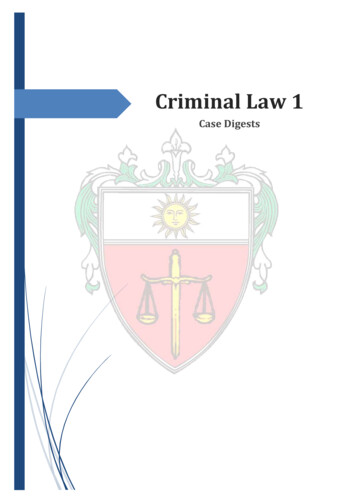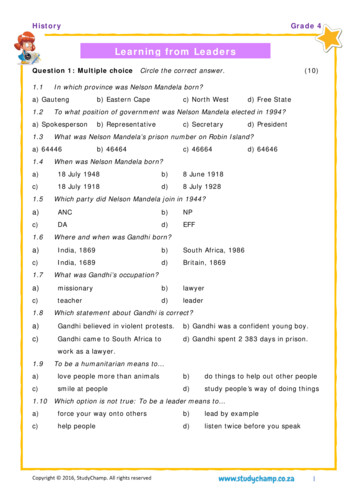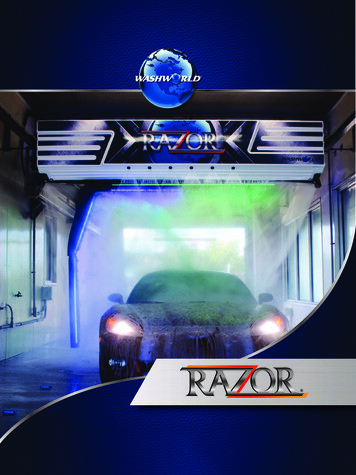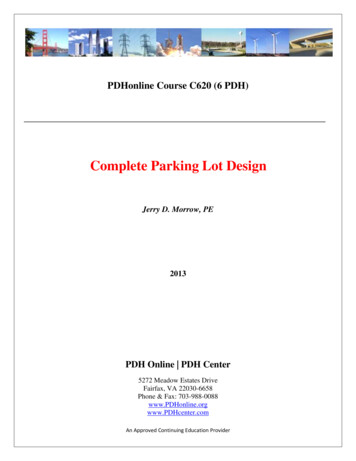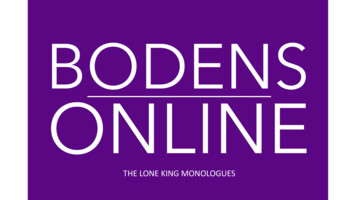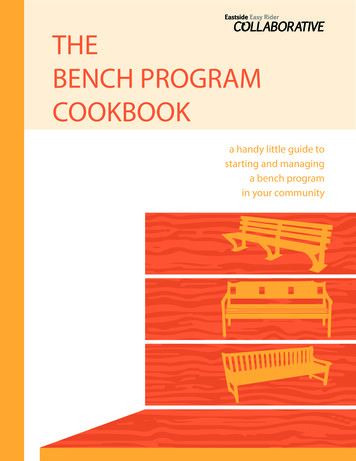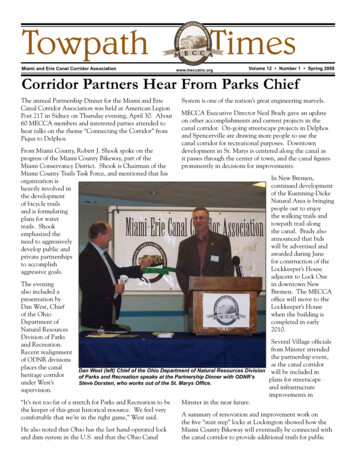Transcription
An Introduction to the Parashat HaShavuah(Weekly Torah Portion)Understanding the Torah From a Thematic PerspectiveShoftim(Judges)By Tony RobinsonCopyright 2003 (5764) by Tony Robinson, Restoration of Torah Ministries. All rights reserved.
—The Family House of Study—Examining the Parashat HaShavuah byThematic AnalysisWelcome to Mishpachah Beit Midrash, the Family House of Study. Each Shabbat1 we gather inour home and study the Scriptures, specifically the Torah.2 It’s a fun time of receiving revelationfrom the Ruach HaKodesh3. Everyone joins in—adults and children—as we follow the ParashatHaShavuah4 schedule. We devote ourselves to studying the Torah because the Torah is thefoundation for all of Scripture. Therefore, a thorough understanding of the Torah will help usmore fully understand the rest of the Tanakh5 and the Brit Chadasha.6 Furthermore, as Yeshuastated Himself, the Torah teaches about Him. So we study the Torah in order to be drawn closerto Yeshua, the goal of the Torah.As believers in the Messiah we have discovered the richness of the wisdom of the sages of Israel.These men, who devoted themselves to the study of the Torah, have left us a rich heritage. Partof that heritage is a unique method of learning and interpreting the Scriptures. It’s calledthematic analysis. In thematic analysis we search for the underlying theme/topic of each passageof Scripture. By studying Scriptures related by a common theme, line upon line and preceptupon precept, the Scriptures open up to us in a unique manner that is clearly inspired by theRuach HaKodesh. Passages that seemed obscure begin to make sense, and numerous levels ofwisdom and understanding unfold before us.Thematic analysis of Scripture is based on the following premises. 1) Moses wrote the Torah asfive separate books as the Ruach HaKodesh inspired him. 2) Since Adonai had him separatethose words into five separate books, we surmise that each book has a unique message or theme.3) Within each book, the words are written with two paragraph-like divisions7 interrupting theflow of the words. 4) Since Adonai commanded Moshe to separate the individual books intosmaller paragraph-like sections or Parshiot, we surmise that each Parsha was written as aseparate unit because each of those Parshiot is trying to convey a unique thought, theme, conceptor understanding. Therefore, since Adonai inspired these divisions, we think they are VERYimportant. We use these God-breathed divisions as the basis of our thematic analysis ofScripture. Once you begin to interpret the Scriptures thematically, you will immediately SEEthat Adonai wrote His words in a manner consistent with the intent that they be interpretedthematically.Here is an example of what the Parsha divisions look like Page 2 of 19
s—Parsha Stumah (plural, stumot)—A paragraph-like break inspired by the Ruach HaKodesh,still preserved on kosher Torah Scrolls, where there are at least nine blank spaces between aword and the next word, all on the same line of text.p—Parsha P'tuchah (plural, p'tuchot)—A paragraph-like break inspired by the Ruach HaKodesh,still preserved on kosher Torah Scrolls, where there are blank spaces extending to the end of aline of text and the subsequent text does not begin until the next line. (Hebrew is read from rightto left)Page 3 of 19
—ParashatHaShavuah— yi j . p o fShoftim(Judges)Devarim 16:18-21:9(Deuteronomy 16:18-21:9)123456789101112131415161718Page 4 of 19Devarim 16:18-20 sDevarim 16:21-22 sDevarim 17:1 sDevarim 17:2-7 pDevarim 17:8-13 sDevarim 17:14-20 sDevarim 18:1-2 sDevarim 18:3-5 sDevarim 18:6-8 sDevarim 18:9-22 sDevarim 19:1- 10 pDevarim 19:11-13 sDevarim 19:14 sDevarim 19:15-21 sDevarim 20:1-9 sDevarim 20:10-18 sDevarim 20:19-20 pDevarim 21:1-9 s
Understanding the ParshaDevarim 16:18-17:7Objective—Learn how to 1) interpret the main theme of a Parsha, 2) make thematic connectionsto that Parsha and 3) learn how to gain greater understanding of the Parsha underconsideration through its thematic connections to other portions of Scripture.Understanding the Parsha BreaksI.In the introductory teachings you learned that the Torah was written with two paragraph-likedivisions called Parshiot (Parsha, singular). Although each Parsha represents one completethematic subject, there is a significant difference in understanding between the two. Ingeneral, a Parsha P’tuchah is used to signal a major change in theme/topic/subject, whereas aParsha Stumah is used signal a lesser change in theme/topic/subject.A. Read Devarim 16:18-17:7. Pay close attention to the Parsha breaks (listed at thebeginning of this lesson) and the subject changes. Note the following outline of thethematic flow: Devarim 16:18-20 s—The establishment of judges and officers (court system) toimplement righteousness.Devarim 16:21 s—Prohibition against erecting idolatrous trees.Devarim 17:1 s—Acceptable offerings.Devarim 17:2-7 p—The death penalty for idolaters.Upon first reading, the Parsha breaks may seem somewhat erratic. Note how someParshiot are only one verse long! What are we to make of these strange markings? Well,as stated before, Adonai inspired these divisions; therefore, they’re important. Thesedivisions are the basis for many of the Torah’s teachings. Since we know that 1) a ParshaStumah normally only signals a small change in subject and 2) a Parsha P’tuchah signalsa major change in subject, we should surmise that Devarim 16:18-17:7 may have oneunified theme, even though there appears to be a digression in their flow. Let’s examinethis more closely.B. Read the outline above and take note of its general flow. The theme of Devarim 16:1820 pertains to righteousness and judgment. The theme of Devarim 17:2-7 also pertains torighteous judgment. Right? This is evidence to support my assertion that Devarim16:18-17:7 has a complete unified theme even though there seem to be digressions withinit. Moses started off talking about righteousness and judgment (Devarim 16:18-20) andended speaking about righteous judgment. But what about the two Parshiot betweenthem. They sort of digress, shall we say. We’ve seen how the two “outer” Parshiot arethematically related through the theme of judgment. Could these two “inner” Parshiot bethematically related? If so, how?8 That’s right. The flow seems to look like this: Devarim 16:18-20 s—Judgment and Righteousness.Devarim 16:21 s—Altar.Page 5 of 19
Devarim 17:1 s—Altar.Devarim 17:2-7 p—Righteous Judgment.Of what type of literary structure does this generic outline remind you?9 Remember, theTorah uses its own literary techniques, which we would do well to understand. TheseParshiot are organized as a chiastic structure. We’ve seen this many times before. Achiastic structure is essentially a thematic method of organizing the narratives of theTorah. A chiastic structure is a pattern organized as follows. Generally, a story isdivided into two halves. The themes of the first half of the literary unit are repeated inthe second half of the unit in reverse order. Furthermore, both halves of the story pointto the central axis, the most important element in the narrative. Let’s apply this to ourParshiot, by carefully dividing them thematically. Then we’ll examine it to see thebeautiful pattern.A) Devarim 16:18-20—Appointment of judges and officers to pursue righteousness.B) Devarim 16:21—Prohibition against setting up trees near the altar.C) Devarim 17:1—Acceptable offerings (sacrifices).B1) Devarim 17:2-3—The idolater.A1) Devarim 17:4-7—Conviction and execution of the idolater.C. Compare A and A1. What is the thematic connection between them?10D. Compare B and B1. What is the thematic connection between them?11E. As we view this chiastic structure, we are immediately drawn to the central axis, C. AsI’ve stated, the central axis is the most important part of the chiastic structure. The twohalves of the story always depend upon the central axis. Therefore, the question becomesthis, “What do acceptable offerings have to do with the two halves of the chiasticstructure?”1. First, let’s note the key words in this chiastic structure. Obviously, righteousness isone key word because it is the theme of the two halves of the chiastic structure. Theother key word is offering, which is found in the central axis. Therefore, the Torahhas taught us that there is a thematic connection between righteousness and offerings.In order to make the thematic connection, let’s cheat by noting how the prophetsoften connected righteousness and sacrifice. Read Psalm 51:16-19. How is thispassage thematically related to the chiastic structure?12 Based on the thematicconnection between Psalm 51:16-19 and our chiastic structure, what lesson can wesay the chiastic structure is trying to teach?13 That’s right! The chiastic structure isthe Torah’s “language” for teaching what is found in Psalm 51:16-19! Remember,chiastic structures are not just literary fluff. Adonai arranged His Words in thesechiastic structures to teach us deeper spiritual truths. Our job is to learn the Torah’slanguage (e.g., chiastic structures) and then apply our knowledge so that we can gainall the wisdom He has for us. This concept, that offerings/sacrifices are onlyPage 6 of 19
acceptable within the context of righteous living on the part of the one making theoffering, is a fundamental message of the prophets.2. Read Malachi 3:2-3. How is Malachi 3:3 thematically related to our chiasticstructure?14 Other verses that teach this relationship are Devarim 33:19, and Psalm4:5. Read Proverbs 21:3. What are the three subjects of this verse?15 How are theyrelated to the chiastic structure?16 Note how the concepts of justice as well asrighteousness in Proverbs 21:3 are thematically related to our Parsha! Also, in Isaiah1:26, note the result of the restoration of judges? Jerusalem will be called a City ofRighteousness!In summary, the message of the chiastic structure is this: The acceptablesacrifice/offering is the one made in righteousness. The chiastic structure is the literarydevice the Torah uses to teach this. Lastly, we can see once again that oftentimes there isone overall theme between each Parsha P’tuchah, even though there may be numerousParsha Stumah’s between them. This was such an example. There were three ParshaStumahs before the final Parsha P’tuchah. One may have been tempted to analyze theseParshiot separately. Especially considering the seemingly major topic change betweenDevarim 16:18-20 s (the establishment of judges and courts to implementrighteousness) and Devarim 16:21 s (the prohibition against erecting idolatrous trees).However, by analyzing each Parsha thematically and connecting them thematically, wediscovered a chiastic structure that clearly tied each Parsha to each other as one completeunit. This chiastic structure, which utilized seemingly unrelated Parshiot, blossomed intoa teaching concerning a foundational topic (righteousness as a prerequisite for sacrifice)echoed by the prophets.Searching the ParshiotObjective—Learn how to 1) uncover the theme of a passage, 2) relate it to other passages and 3)gain new insight on how to interpret the original passage based on its thematic connection tothose other passages.A Nation of RighteousnessI.Let’s continue our study of the Parsha Devarim 16:18-17:7. In context, we know that AmYisrael is about to enter the Promised Land and settle it. Moses will soon die, and is,therefore, teaching them the most important doctrines they will need upon entering the land.This Parsha has emphasized the importance of righteousness within Eretz Yisrael (the land ofIsrael). Therefore, we know that Moses thinks righteousness will be a very importantcharacteristic for the new nation. Can you make a thematic connection between the conceptof a righteous nation and the calling of Abraham?17 Read Genesis 18:16-20. Pay closeattention to Genesis 18:19. As you can see, the Holy One’s purpose in calling Abraham wasto establish through him a nation characterized by righteousness and justice. In fact, Genesis18:19 clearly states that it is through these two virtues that the Holy One will be able to causeAm Yisrael to be a blessing to all the nations of the earth! The idea that Am Yisrael will be aPage 7 of 19
nation of righteousness and justice (remember Malachi 3:3) was on the heart of the Holy Onefrom the moment He called our Father Abraham to follow him.Why a Nation of Righteousness?I.II.III.IV.Read Genesis 18:1-19:38. Note that there are no other parsha divisions in this story!A. What does the fact that Genesis 18:1-19:38 is one complete Parsha tell us concerning theentire content of this parsha?18B. How many stories or topics are in this parsha?19 At first glance do they appear to beunrelated stories?20C. Even though they seem to be independent stories/topics, what is the significance that theyappear within the same parsha?21What theme, words, subject, etc. (thematic connection), is common to both stories?22A. Discuss how this common theme relates to both stories.23So far we have not noted any actual textual evidence that the two stories are related. Wehave simply deduced that they are related since they are part of the same Parsha. What wereally need is explicit textual evidence thematically linking the two stories. In order to makethe thematic connection between the story of the promise of a child and the destruction ofSodom clearer, let's see if we can determine if there are any verses that connect the twostories. Read B’reishit 18:17-19.A. Now explain how these verses thematically link the story of the promise of a son to thedestruction of Sodom.24 There you have it. Concrete textual evidence linking the twostories! What reason does Adonai give for deciding to tell Avraham what He’s about todo?25 Please note Adonai's reasoning. Abraham's descendants will become a greatnation AND as a nation, his descendants will bless other nations AND the future nationwill be characterized by righteousness and justice (which, by the way is thematicallyrelated to the Devarim 16:18-17:7, the reason why we're studying this story—in caseyou're lost ).B. Why does Torah make this thematic connection between these two stories?26C. Now read Genesis 18:19. This verse tells us that there is a prerequisite that must be metBEFORE Adonai can "bring upon Abraham all that which He had spoken to him." Whatwas "all that which He had spoken to him?" It was the promise that Abraham'sdescendants would bless all other nations. So what was the prerequisite that needed to bemet before Adonai could cause all nations to be blessed by Abraham's descendants?27The Torah now proceeds to show us how Abraham tries to save Sodom! Thematically, whatis the one word that describes Abraham's actions as he tried to save Sodom?28A. What is the basis for Avraham asking Adonai not to destroy Sodom?29B. Knowing that Adonai’s will is that all come to repentance, why would he not destroy anation for the sake of the righteous within it? Let's take inventory. Abraham, one man,tried to save one nation, Sodom, by interceding for them. We know that Abraham wasrighteous. Furthermore, we know that he was definitely trying to be a blessing to Sodom.Do you see where I'm going? Now note the thematic parallel here. Adonai's plan is thatthe righteous nation made of Abraham's descendants would be a blessing to all nationsjust as Abraham was trying to be a blessing to Sodom! Wow!Page 8 of 19
V.C. You have just seen another example of how actions of the Patriarchs are propheticforeshadows of future events in the lives of their descendants! The story of righteousAbraham trying to be a blessing by interceding for Sodom is a foreshadowing of how thefuture nation of Israel will be a blessing to all nations of the earth. Through the righteousnation of Israel, Adonai wants to save other nations! That's the connection.Wrapping up the thematic connection between the two seemingly unrelated stories (thepromise of the birth of Isaac and the destruction of Sodom and Gomorrah) of our parsha:A. Adonai plans to make Avraham into a great nation. This nation is destined to becomeone that represents the one and only true Elohim (God) to all other nations. They are tobe a nation that practices righteousness and justice. In this manner they will be a blessingto all nations, showing them true righteousness and justice so that they can performproper teshuvah (repentance) and not need to suffer divine judgment (remember the floodand the generation of the tower of Babel). The other nations will perform teshuvah as aresult of the example of righteousness and justice found in Israel and their intercessionon behalf of those nations (remember how Jonah saved Ninevah). In order to impressupon Avraham Avinu (Abraham, our Father) the scope and gravity of his calling, Hegave Avraham a chance to see what would happen to mankind (the judgment of Sodomand Gomorrah) without the positive influence of a nation characterized by righteousnessand justice. This real-life example will serve to motivate Avraham to fulfill his calling tobe the father of such a nation. This interpretation helps to explain how these twoseemingly unrelated stories are truly related. Their juxtaposition in a common parshahelps us to make the connection.The Four Offices of LeadershipI.II.This week’s sidra focuses on some of the roles of Am Yisrael’s national leaders. ReadDevarim 16:18-17:13. Which national leadership role is taught in these passages?30 ReadDevarim 17:14-20. Which national leadership role is taught in these passages?31 ReadDevarim 18:9-22. Which national leadership role is taught in these passages?32 ReadDevarim 19:1-21:9. Who is the most prominent person in these chapters?33 How are thesefour passages of Scripture thematically related?34Read Devarim 18:9-22. What is the general theme of Devarim 18:9-14?35 Now readDevarim 18:15-22 and explain how these two passages are thematically related?36 Whatrationale does the Holy One give for providing Am Yisrael with a prophet?37 You may recallthat when the Torah was given (Matan Torah, the giving of the Torah) the people thoughtthey would die from hearing the audible voice of Adonai (Exodus 20:15-18). In accordancewith their words, the Holy One spoke to Moses, who then relayed the words to the people.Now we see that Adonai intends to use this arrangement to continue to speak to Am Yisraelin future times.Instructions to Atone For Unsolved MurdersI.Read Devarim 21:1-9. We have seen that Adonai is extremely concerned that ALL spilledblood is atoned for. After reading this passage, I noted some of the following importantwords and phrases:Page 9 of 19
Unsolved MurderCorpseHeiferA harsh valley that cannot be worked or sownDeath of the heiferInvolvement of Priests and EldersWashing of handsAtonementThe closest cityWhenever we read a passage like this, we immediately begin to wonder, "What in the worldis this all about?" Well guess what? I'm thinking that at this very moment. Although I'mconfused, I know that thematic analysis is the key to understanding this passage. I may notget all of the revelation now; however, analyzing this passage thematically will 1) put us onthe right track, and 2) lay the proper foundation for gaining a greater understanding later.A. In order to understand this passage we need to understand its general theme/subject.What is the general message you think this passage is trying to convey?38 Okay, thisgives us a start. Can you think of another passage of Scripture thematically related to 1) acorpse, 2) a heifer, 3) death of a heifer,4) the involvement of priests and 5) atonement?39Wow! I think we've hit the mark! Whenever someone came into contact with a corpse,they needed to be cleansed through sprinkling of water containing the ashes of the redheifer. Previously, we've learned that ALL contact with death must be atoned for. Thisceremony was performed to cleanse the person from their contact with the realm of death.Obviously, this applies in this passage, since a corpse is present.B. Can you think of another passage of Scripture thematically related to 1) murder, 2) the"closest city," 3) involvement of priests and atonement?40 Wow! We can clearly seeallusions to the cities of refuge. What's the thematic connection between our passageunder discussion and cities of refuge involving the words city and close?41 Cities ofrefuge were places where an unintentional murderer could flee until the death of the HighPriest. It was the death of the High Priest that atoned for the blood shed by theunintentional murderer. Now we have a better picture of the instructions found inDevarim 21:1-9. But wait, there's more.C. When we studied the cities of refuge we saw clear allusions to Genesis 4 involving thesin of Cain's murder of Abel. Remember? Read Genesis 4. How did the Holy One“know” that Abel had been slain?42 Explain two ways Genesis 4:11-14 is thematicallyconnected to the discussion of cities of refuge.43 How is Genesis 4:15 thematicallyconnected to the discussion of cities of refuge?44 As you can see, thematic analysis hasallowed us to see an important teaching. The themes are consistent, clear and easy to see.The instructions pertaining to unintentional death have roots that reach all the way backto Genesis 4! Now let's see how Genesis 4 has clear thematic connections to Devarim21:1-9. Whose responsibility was it to secure atonement for the corpse that was found?45How is this thematically related to the story of Cain and Abel?46 Concerning the placedescribed as, "a harsh valley that cannot be worked or sown," how is the passage inGenesis 4 thematically related to Devarim 21:1-9?47 As you can see, Genesis 4 containsPage 10 of 19
most of the elements taught in the passages dealing with the unintentional murders andunsolved murders. The thematic allusions are clear and strong.In summary, the instructions in Devarim 21:1-9 are clearly related to 1) cities of refuge,2) the ashes of the red heifer, and 3) the first murder. The thematic connections to theseother passages help us better understand the purpose of the instructions concerning theunsolved murder.Making the Connection Between the Parashat HaShavuahand the HaftarahObjective—Learn how to relate Scriptures thematically, thereby learning how to thinkHebraically. Become rooted in the importance of thematic analysis by seeing it in action as yourelate the Torah portion to the Haftarah portion.The Haftarah reading is found in Isaiah 51:12-52:12. I will list some verses from the Haftarahreading. Your job will be to relate them thematically to the Parashat HaShavuah reading.I.This is a rather difficult Haftarah portion to thematically connect to the sidra (Torah portion).Can you find at least one thematic connection between the Haftarah reading and this week’sTorah portion—that's all I could find ?48 Read Isaiah 51:16. Isaiah used the phrase, "Ihave placed my words in your mouth." This is what happens when a prophet receivesrevelation from the Holy One. Many of the prophets said that Adonai had placed His wordsin their mouths. This is thematically connected to Devarim 18 where Moses discusses theinstitution of prophet.Messiah in the ParshaObjective—Learn how the Torah teaches about the life and ministry of Yeshua HaMashiach.Yeshua said that Moses wrote about Him49. Since the Torah never even mentions the wordMessiah, this section will help you see the Messiah in the Torah. This is primarily done usingthematic analysis and midrash.The Work of Messiah YeshuaI.Earlier, we learned that there were four leadership functions described in this week's sidra(Torah portion)—judge, king, prophet and priest. I've stated many times before that theevents in the Torah are prophetic. They are pictures of events that will occur in the lives ofthe descendants of the Patriarchs. The ultimate descendant of the Patriarchs is MessiahPage 11 of 19
II.III.IV.Yeshua and many of the Torah's narratives are glimpses into His redemptive role. Let's lookat these four roles and see how they teach us about the work of the Messiah.—Judge—A. Read Malachi 3:1-7. In Understanding the Parsha, we learned that the Holy One wasvery much concerned about righteousness, judgment and acceptable offerings. Malachi3:1-2 states that Adonai will send a messenger to prepare the way before the Lord comes.We know that this refers to John the Baptist at Yeshua's first coming. Furthermore, weknow that it refers to Elijah at His second coming. But note what will happen when theLord comes. Malachi 3:3 states that He will sit as a refiner's fire. What does this mean?It means that He will purify His people because of His righteous judgment. Note howthis aspect of judgment is taught in Malachi 3:4. Also note that Messiah's judgment willresult in offerings that are acceptable to the Holy One. Is this not exactly what welearned in Understanding the Parsha through thematic analysis? Furthermore, note howMalachi 3:5 is thematically related to Devarim 16:18-17:7 and 18:9-14—Messiah willdeal with sorcerers, another form of idolatry.B. We learned the concept of a righteous judgment through thematic analysis of Devarim16:18-17:7. Now note how often this theme is applied to the Messiah—Psalm 7:8,11;9:8; 50:6; 58:11; 72:2; 96:13; 98:9; Isaiah 11:4; Jeremiah 11:20; 2 Timothy 4:8; Acts17:31 and Hebrews 12:23! Messiah Yeshua is the ultimate judge who will judge theearth in righteousness.C. Read Revelation 5:1-6. Why do you think Yeshua was the only one who was worthy toopen the seven seals (OF JUDGMENT)?50 As you can see, the two concepts ofrighteousness and judgment meet in the Messiah. In Revelation 5:6, Yeshua is referred toas a Lamb that had been slain. How does this thematically relate to righteousness andjudgment?51 We know that Messiah Yeshua's offering was acceptable because He wasthe sinless Son of Elohim (God).—King—A. Read Revelation 19:16. Note that one of the Titles of Yeshua is King of Kings.B. Do you know which verse from the Tanakh thematically connects the Messiah tokingship?52C. What role(s) will Yeshua fulfill at His second coming?53—Prophet—A. Read Devarim 18:9-22. Earlier, we noted that when the Torah was given (Matan Torah;the giving of the Torah), the people thought they would die from hearing the audiblevoice of Adonai (Exodus 20:15-18). In accordance with their words, the Holy One spoketo Moses, who then relayed the words to the people. Deuteronomy 18:9-22 teaches usthat the Holy One plans to use this arrangement to continue to speak to Am Yisrael infuture times.B. Which portion of Devarim 18:9-22 seems to imply that Moses is speaking about asuccession of many prophets coming to Am Yisrael?54 These verses seem to imply thatthere may be more than one prophet who will be sent to Am Yisrael. However, whichportion of Devarim 18:9-22 seems to imply that Moses is speaking about one particularprophet?55 How does Moses describe the prophet who is to come? He will be an Israelite.He will be like Moses.Page 12 of 19
He will speak the Holy One’s words to Am Yisrael.Adonai will hold everyone accountable to the words that prophet speaks.This is one of those rare passages in the Torah where Moses gives an explicit promiseconcerning the Messiah. For the most part, we have seen the Messiah through midrashand foreshadows. Therefore, this passage is very important. Throughout this Torahseries, we have seen numerous times how that prophet (whom we know to be MessiahYeshua) will be like Moses. We have seen many, many parallels between the life ofMoses and Yeshua. I'd like to posit that Moses' statement that The Prophet will be likehim is a veiled prophecy that Moses' entire life is a picture of the Messiah. If you've beenstudying with MBM since the book of Exodus, then you know that last statement is true.C. Of all of the gospel accounts, the book of John seems to be clearly thematically related toMoses' statements that, "I will place my words in His mouth and He will speak to themeverything that I command Him." Read John 5:18-46 and note how Yeshua points to theFather as the source of His message. Note John 3:34-34 and John 14:10.34For He whom God has sent speaks the words of God, for God does not give the Spirit bymeasure. 35The Father loves the Son, and has given all things into His hand. 36He who believes inthe Son has everlasting life; and he who does not believe the Son shall not see life, but the wrathof God abides on him (John 3:32-34).Do you not believe that I am in the Father, and the Father in Me? The words that I speak to you Ido not speak on My own authority; but the Father who dwells in Me does the works (John 14:10).D. The one verse in the B'rit Chadasha (New Testament Scriptures) that is most clearlythematically linked to Devarim 18:9-22 is Hebrews 11:1.God, who at various times and in various ways spoke in time past to the fathers by the prophets,2has in these last days spoken to us by His Son, whom He has appointed heir of all things, throughwhom also He made the worlds (Hebrews 1:1-2).V.E. Note the language of John 1:21, when the priests questioned John the Baptist concerninghis identity. They asked him, "Are you that prophet?" Note, they didn't say are you aprophet. Why? Because they understood that Devarim 18:9-22 was a prophecy of aspecific prophet, Messiah!F. Lastly, what role did Yeshua fulfill at His first coming?56—Priest—A. Let us return again to our principle that events in the lives of the Patriarchs are propheticforeshadows of future events in the lives of their descendants. In Searching the Parsha,we learned that Am Yisrael was chosen to be a nation of righteousness so that they couldbe a blessing to all people. That story taught us that without the influence of such arighteous nation in the world, nations such as Sodom would be doomed to destruction.We saw that Abraham's act of intercession on behalf of Sodom was a prophetic picture ofthe future role of Am Yisrael as a source of redemption to the rest of the
We devote ourselves to studying the Torah because the Torah is the foundation for all of Scripture. Therefore, a thorough understanding of the Torah will help us more fully understand the rest of the Tanakh5 and the Brit Chadasha.6 Furthermore, as Yeshua stated Himself, the Torah teaches about Him. So we study the Torah in order to be drawn closer

